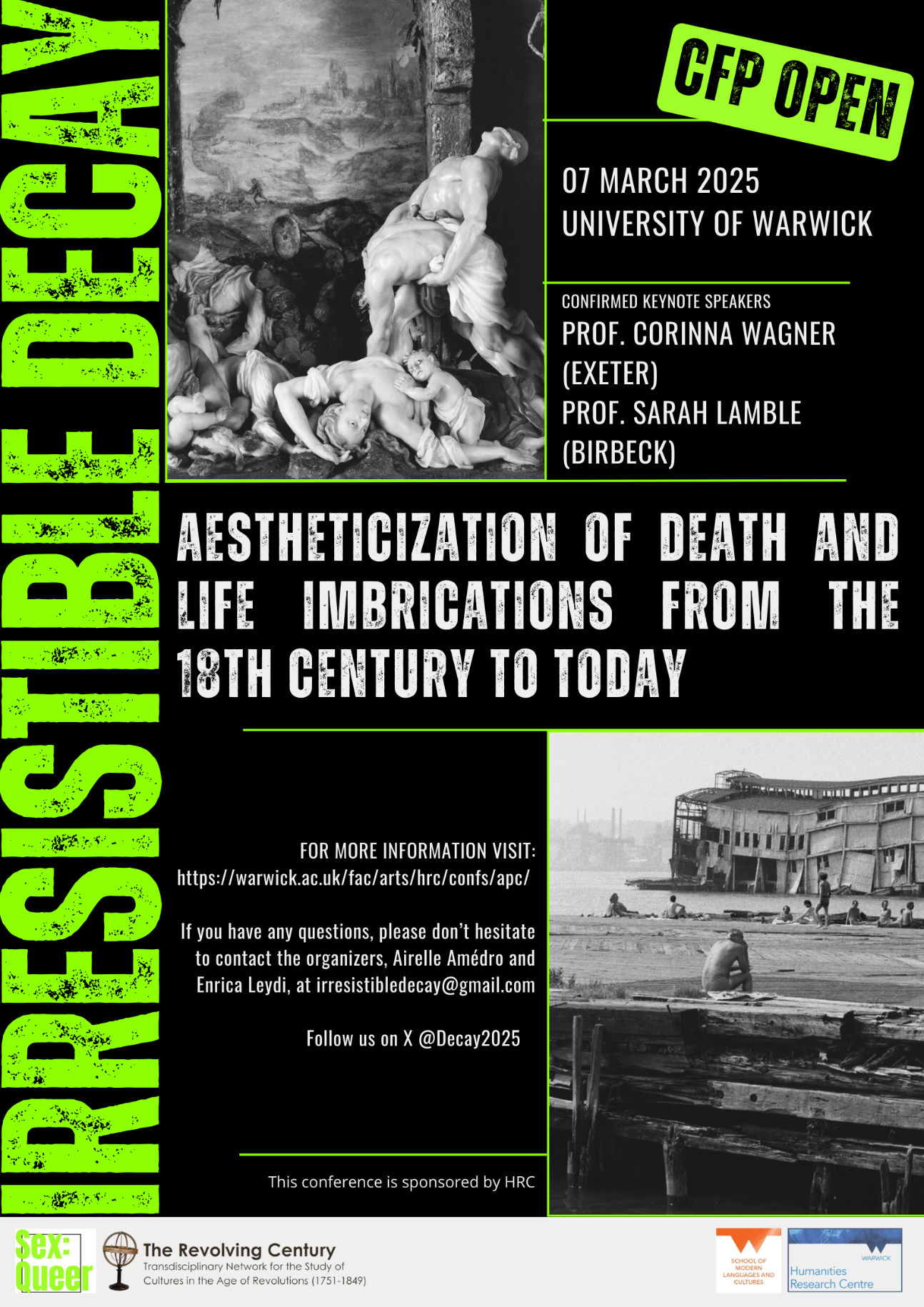
Irresistible Decay. Discourses of Death in Life from the 18th Century to Today (Univ. of Warwick)
While we received a high volume of truly exciting submissions for the conference Irresistible Decay: Discourses of Death in Life from the 18th Century to Today, we are extending the deadline to further the interdisciplinarity of the event! As such, we are encouraging abstracts analysing contemporary discourses or intermedial representations of death in life across fields including (but not limited to): queer and sex studies, human rights, criminology, sociology, and medical humanities. We are particularly keen to receive abstracts concerned with matters such as neoliberal violence, carceral culture, necropolitics, moral panics, biopolitics and moral and democratic decay.
The event will take place at the University of Warwick on the 7th of March 2025. The deadline to submit an abstract is now the 22nd of December. This interdisciplinary conference is sponsored by the University of Warwick's Humanities Research Centre.
Airelle Amédro and Enrica Leydi
—
Irresistible Decay:
Discourses of Death in Life from the 18th Century to Today
7 March 2025 - University of Warwick
Confirmed keynote speakers:
Professor Corinna Wagner (University of Exeter)
Professor Sarah Lamble (Birkbeck, University of London)
According to Julia Kristeva, decay is a ‘privileged site of mingling, of the contamination of life by death, of begetting and ending’ (1982). As a cyclic organic process where life and death inexorably meet, decay is an irresistible metaphor in social, artistic, medical, and political investigations. Since the 18th century, its malleable imagery has lent itself to both the most emancipatory and the most oppressive ideas.
In the 18th century, etchings by Giovanni Battista Piranesi exemplified an epochal Ruinenlust, while scientific studies, such as those by Jean-Baptiste Lamarck, conveyed a novel interest in organic matter and its transformations. This fascination with degeneration soon infiltrated political discourses, participating in the proliferation of an ‘undifferentiated image of “rottenness”’ which became a shorthand for the ‘corruption of morals as much as the decomposition of flesh’ (Foucault, 1963). In the following centuries, decay was used as a metaphor to express fears around atavism and eugenics, serving as a rhetorical tool for biopolitical discourses. This rhetoric still prevails in current political anxieties and moral panics. In our contemporary society, Achille Mbembe argues, the governing logic of capitalism turns humanity into ‘an extravagant carcass’ which ‘struggl[es] to escape the dust’, making our relationship to the organic world ‘ecocidal’ (2003). Necropolitical practices have infiltrated liberal activist circles, particularly through the investment in the punishment of others for individual protection (Lamble, 2013). Against what they identify as moral decay, carceral feminists for instance participate in the infringement of sex workers’ rights and the movement’s gender-critical strand stands against the rights and freedoms of trans people (Butler, 2023).
Alongside these morbid figurations of decay, positive interpretations emphasizing its generative potential have emerged since the 18th century. These approaches often highlight destruction as an essential element in cycles of rebirth and regeneration and stress the interconnectedness of human and nonhuman realms. The aforementioned Piranesi etchings, for instance, depict nature reclaiming architectural ruins and thus embody the inherent ambiguity of decay as a symbol of both decline and life. Furthermore, the rise of ecological awareness, particularly in this time of climate emergency, has led to a growing re-reading and reinterpretation of cultural products from the past. Tom Nurmi’s Magnificent Decay (2020) reinterprets Herman Melville as a proto-ecologist, insofar as his work offers valuable insights into the ecological challenges of the Anthropocene today. In a similar gesture, Jack Halberstam’s recent work invites us to embrace the aesthetics of collapse and urban decay inherent to ‘the world of predatory capitalism’ to partake in a radical project of world unbuilding (2022).
This conference will examine the irresistibility of decay by proposing to explore different discourses of death in life across time, media, geographies, and disciplines. We invite papers reflecting on, but not limited to, the following questions:
· Forms of Aestheticization: How has the aestheticization of decay been manifested in different artistic, literary, and cultural contexts from the 18th century to today?
· Exploitation of Decay Imagery: In what ways has the irresistible imagery of decay been utilized in past and present historical, political, sociological, legal, medical, and philosophical discourses?
· Decay in the Anthropocene: What insights can decay as an organic process offer concerning discussions around biodiversity, ecosystems, and life in the Anthropocene?
We invite scholars to submit a short abstract (maximum 300 words) and a biographical note (maximum 150 words) to Airelle Amédro and Enrica Leydi at irresistibledecay@gmail.com by the 22nd of December.
Participants may also be invited to publish their contributions in an edited collection. For inquiries, please contact Airelle Amédro and Enrica Leydi at irresistibledecay@gmail.com, visit our Conference Website or follow us on X @Decay2025. This conference is sponsored by the Humanities Research Centre (HRC) at the University of Warwick. We look forward to your contributions to this vibrant and interdisciplinary exploration of decay.